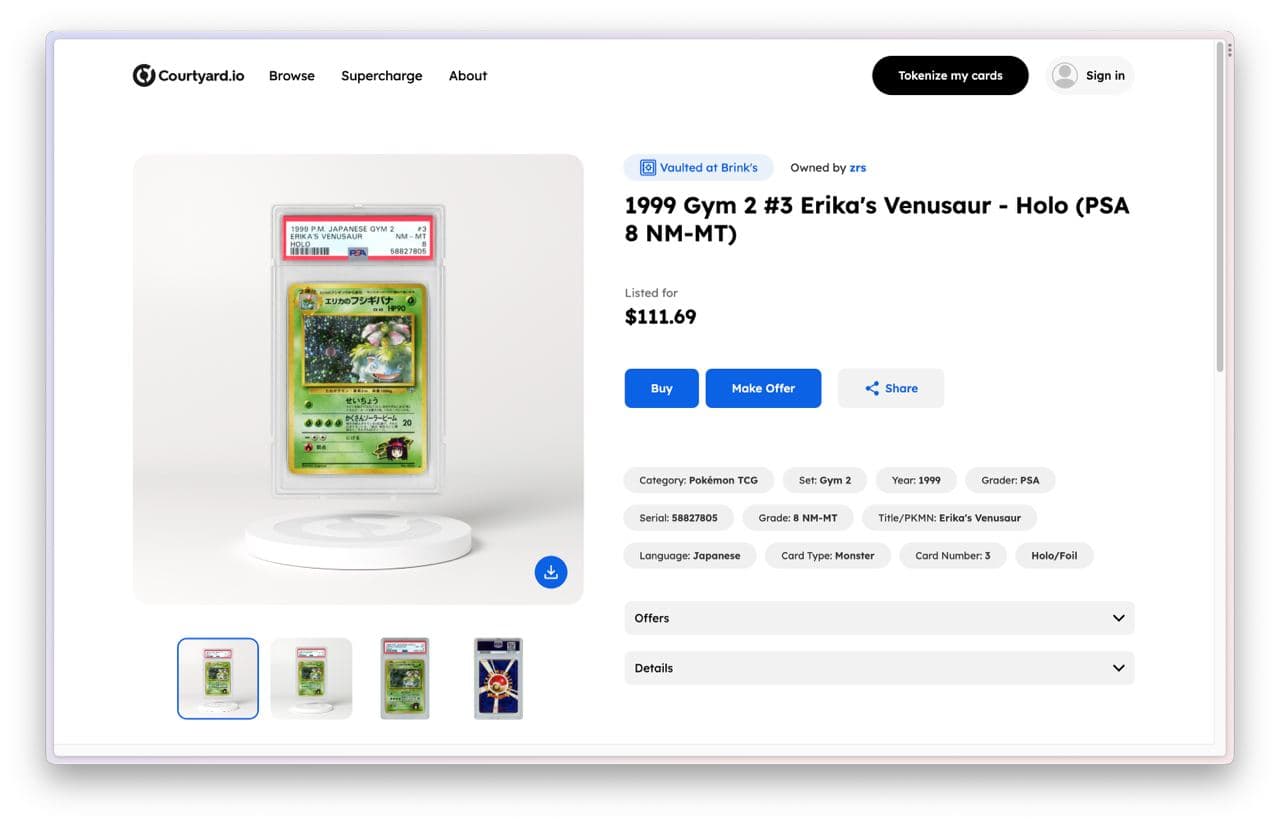Courtyard.io: Reimagining real-world asset trading
Domesticating the blockchain for real-world users
Ankush Swarnakar
|Aug 21, 2023

A key part of Privy’s vision is enabling developers to build delightful user experiences supercharged by blockchain infrastructure under the hood. Web3 developers often find the ecosystem’s principles of decentralization and self-custody at odds with familiar, easy-to-use product experiences.
At Privy, we believe this doesn’t have to be the case. The next generation of the Internet can only be realized if we build novel ways for users to take control of their digital identity and financial assets, without forcing them to chew through endless complexity and niche technical know-how.
Introducing Courtyard.io
One of Privy’s most exciting partners, Courtyard.io, shares this vision. Courtyard.io is building a platform that enables users to tokenize and mint their physical collectibles (rare Pokémon cards, or sneakers for instance) as digital collectibles (NFTs) on the Polygon blockchain. By doing this, collectors are able to access a global base of potential buyers and can list their assets on massive marketplaces like OpenSea. What’s more, since these NFTs can be redeemed 1:1 for the physical asset at any time, Courtyard.io makes it easy for anyone to grow their own collection of rare trading cards, sneakers, comics, and more–all with just a crypto wallet.

Trading physical Pokémon cards as NFTs on Courtyard.io
Web3 for everyone
Privy is especially proud to support Courtyard.io’s latest release, which makes it easy for anyone to mint and trade their physical collectibles as NFTs, regardless of their experience with web3.
Courtyard.io’s launch addresses the big cold start problem web3 user experiences have historically suffered from:
First, most new users don’t already have crypto wallets, and setting one up is a huge point of friction.
Second, even once they have a wallet, the complexity of obtaining assets to pay for gas is a non-starter.
Together, these issues prevent a plethora of users from taking on simple onchain actions, like listing a card onto a marketplace.
Courtyard.io has implemented some of the best UX in the space to solve these challenges, and we couldn’t be prouder to partner with them on this.
Getting a wallet should be as easy as signing in
Setting up a wallet today is needlessly complex. Users have to download a mobile app or browser extension, learn what a seed phrase is, figure out how to store that seed phrase, and deal with finicky app-wallet connections. The drop-off points are endless and the cost of a mistake is huge.
Privy makes getting a wallet as easy as logging in with an email address, phone number, or social account. No additional setup required. Using Privy, Courtyard.io provisions embedded wallets for all of their users, enabling any user to purchase and trade NFTs, even if the user has never used a wallet before.
Apps can also fully customize the UX of Privy’s embedded wallets, ensuring that users see helpful app-specific context and feel right at home when using the wallet. The wallet itself is completely self-custodial—meaning it can only ever be accessed and used by the user—but feels like part of the native Courtyard.io experience. With Courtyard.io, trading NFTs feels like a familiar ecommerce experience, lowering the barrier to entry for users that are new to web3.
Using the wallet should be seamless as well
Once users have a wallet, they need assets like MATIC and USDC in order to purchase/trade NFTs and pay gas fees. Typically, this involves using a fiat on-ramp or a centralized exchange like Coinbase. This process often involves connecting a bank account, going through an arduous KYC review, waiting on an ACH transfer, and regularly dealing with declined payments. It’s too much friction for the average user to get started.
We can break the problem down further by seeing Courtyard.io as a two-sided marketplace, catering to buyers and sellers:
Buyers need to be able to easily pay for Courtyard.io NFTs in familiar ways. To support buyers, Courtyard.io has integrated Privy’s embedded wallets alongside Paper, allowing users to purchase NFTs directly with just a credit card (bypassing crypto on-ramping).
Sellers need to be able to list their NFTs on marketplaces easily, without needing to buy a digital token first (e.g. to pay for gas). To support sellers, Courtyard.io has integrated Gelato with Privy’s embedded wallets, allowing Courtyard.io to pay for gas fees on behalf of their users.
With these integrations, users don’t have to touch a single digital asset before they purchase or list their first NFT. It just works. This first of its kind experience sets the standard of what a frictionless web3 product should feel like and just works for every user–whether they have a wallet or not.
Privy’s embedded wallets implement open standards like EIP1193, and are thus fully compatible with these tools (and many more). These integrations can even further be composed with powerful NFT protocols like Reservoir, which allows Courtyard.io to route and index NFT orders across various other NFT marketplaces like OpenSea, so sellers can tap into all the buyer liquidity across the entire web3 ecosystem.
Where we go from here
Courtyard.io is exactly the sort of platform that we’re building Privy to serve – a mainstream end-user experience, supercharged by blockchain infrastructure under the hood, but accessible to all. Today’s launch gives builders in the space a shining example to follow and we’re incredibly proud to be a small part of it.
We’re so excited to follow all the novel web3 use cases this incredible team inspires.
Care to try the full experience out? Create an account at courtyard.io to get started.

